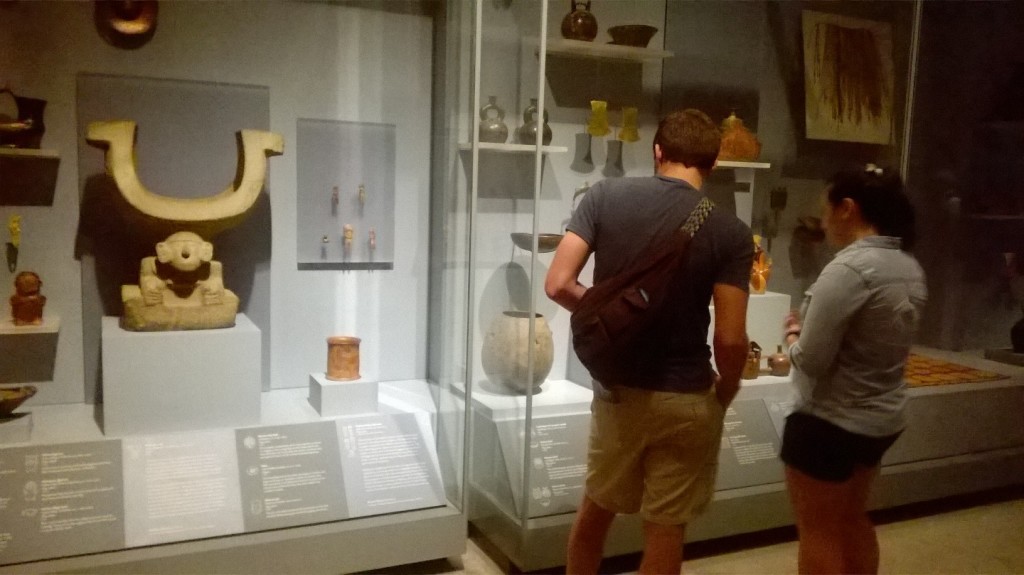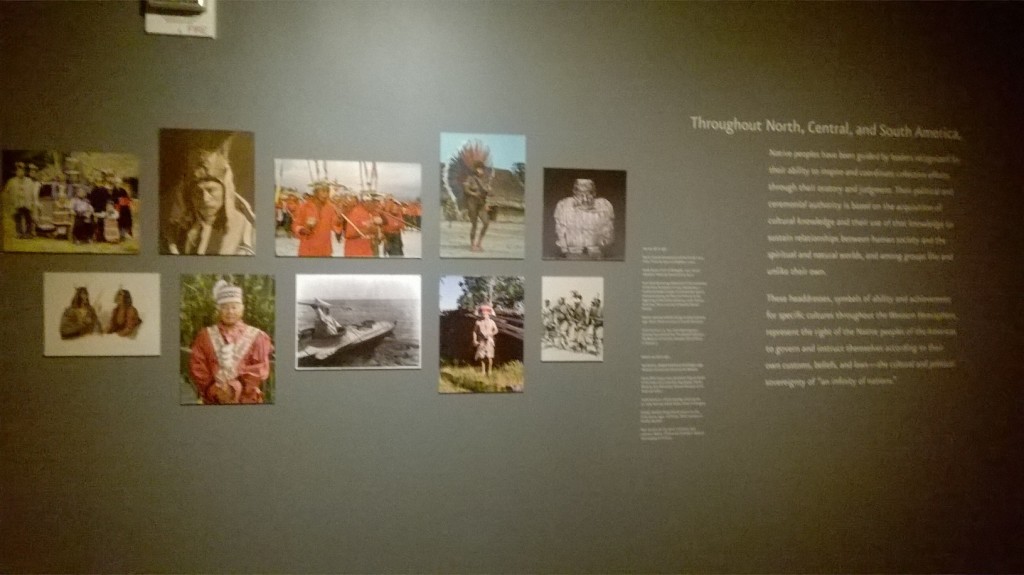A museum becomes truly accessible not just by addressing physical and social barriers in accessibility, but also by crafting introspective spaces for visitors as they visit galleries, writes Nilofar Shamim Haja.
 Image: National Museum of the American Indian, New York. Photo courtesy Nilofar Haja.
Image: National Museum of the American Indian, New York. Photo courtesy Nilofar Haja.
In an earlier post, I spoke about the need for museums in India to transform themselves into inclusive and inviting spaces for visitors who identify themselves across the spectrum of disability. In this post, I would like to address another crucial component of a museum touring experience: museum fatigue. The term is not to be understood literally as “extreme tiredness resulting from mental or physical exertion” (although that is something this post will attempt to address) but rather a waning interest or withdrawal from what is on display. In his paper “What is museum fatigue?” researcher Gareth Davey compiles various studies conducted to understand why visitors lose interest as they progress through a museum’s exhibits. He summarises, “Visitor attributes, the museum setting, and interaction between them, seem to underpin fatigue, and their relative importance differs according to the behavioural changes under investigation.” The term itself was first described by Benjamin Gilman in 1916, credited to have conducted one of the earliest studies on visitor behavior in museums.
“…limited attention capabilities underpin museum fatigue because there is insufficient capacity for attention towards exhibits during later stages of visits (due to the mental effort exerted during initial stages of a visit” – Davey
Museum professionals, including curators, educators and visitor engagement officers, are intuitively aware of this phenomenon. We all know that there’s no stereotypical museum visitor or characteristic museum visiting experience, however, we can ascertain from empirical evidence that depending on whether one is a tourist, a local visitor, traveling singly or in groups, or as part of a guided tour, the experience varies considerably – and so does the degree of enthusiasm, post-visit engagement and repeat visitations. Why is it important for museums and curators to understand this phenomenon? What is at stake here?
 Image: Detailed signage provided alongside the jewelry and precious stone artifacts of the Yei people (Native Indian tribe) exhibited at the National Museum of American History in New York, United States. Photo courtesy Nilofar Haja.
Image: Detailed signage provided alongside the jewelry and precious stone artifacts of the Yei people (Native Indian tribe) exhibited at the National Museum of American History in New York, United States. Photo courtesy Nilofar Haja.
Physical Inertia Towards Exploring
Consider two sets of museum visitors: one, a tourist group from outside the city or country and another, a group of children, part of a local school’s annual excursion. If we consider that the tourist group has visited a couple of other monuments, heritage sites and cultural institutions (art galleries, music venues, historical sites) through the day or couple of days, a visit to one or two museums in a matter of hours would induce fatigue in them. They would be mentally and physically drained to be curious beyond the first 20-30 minutes or enjoy the entire building of collections. It would be different for the school children as they are primed to enjoy the outing as a special event that takes place annually and there are no diversions or detours through the day apart from the visit to the museum.
The behavioural changes that categorise fatigued visitors include cruising through galleries, relatively rapid rates of viewing without rest periods, and increased selectivity towards exhibits – Davey.
The above examples focus very specifically on physical exertion and mental fatigue and how that would affect visitor engagement with collections in a museum. Tillie Baker, PA to Director of Learning, V&A Museum, writes a very interesting article highlighting a series of studies conducted by the museum towards understanding museum fatigue and visitor behavior. “Seating and sitting in the V&A: An observational study” (V&A Online Journal Issue No. 3 Spring 2011), Baker highlights extensive research on public spaces, design and people’s behaviour to underline the importance of creating spaces that invite engagement (within museums). She writes, “Gehl regards seating as one of the most important provisions in public spaces to encourage lingering, because ‘[o]nly when opportunities for sitting exist can there be stays of any duration. If these opportunities are few or bad, people just walk on by’.”
 Image: The National Museum of the American Indian collection includes more than 800,000 objects, as well as a photographic archive of 125,000 images. Photo courtesy Nilofar Haja.
Image: The National Museum of the American Indian collection includes more than 800,000 objects, as well as a photographic archive of 125,000 images. Photo courtesy Nilofar Haja.
As a tourist in New York City this year, I visited several museums and honestly, at the end of each day, I felt exhausted and drained of the desire to reflect on the exhibits and their significance. The experience of a cultural tourist wishing to take in every significant aspect of museums and heritage turned out to be an overwhelming barrage of big exhibitions, colossal collections, vast museum wings with galleries filled with artefacts, inconsistent signage, wayfinding maps, shops, crowded foyers and central halls, and inaccessible navigation. Armed with a degree in archaeology and art history, and another in museum studies, I found myself ill-equipped to enjoy what the museums had on offer.
“One surprising finding from the V&A study was that very few people appeared to use the seating areas to go online – only one person was observed using a laptop during the course of the study, out of a total of 54 Sitters observed. An area for future consideration in the V&A could be to display the WiFi symbol in seating areas to encourage more visitors to make use of the free internet access provided by the Museum.” – Baker.
What these spaces sorely lacked was an introspective corner, hubs of silence or seating arrangements amidst the various galleries that should have induced me to sit, relax, take in the monumental artworks on display, and perhaps, encourage me to talk, share and discuss my feelings online or with other groups. That kind of interactive, intimate discussion forum would have been ideal for visitors who are looking for a meaningful engagement with the collections. Somewhere along the line, the visit became more about making it to the museum, rather than about the collection and its relevance to history and to me (the anonymous visitor). Basically, the visit lacked context and perspective.
How Can Museums Bypass Fatigue?
Since concerted research hasn’t been carried out around the world’s most visited or popular museums or even among smaller museums that see good footfalls, it’s difficult to ascertain the predominance of the museum fatigue phenomenon. Some museums are champions of visitor engagement (think the Smithsonian and the Metropolitan), with consistently higher rankings in visitor satisfaction and it beats logic to think that these spaces could prove to be fatigue triggers for certain visitors.
Image: Explanatory signage of the tribes in North, South and Central America at the National Museum of the American Indian. Photo Nilofar Haja.
However, one must concede that visits to the museum are no longer easy-going, simple and relaxed affairs, especially for tourists. There’s too much crowd, too many exhibits to check out, shops and merchandise to navigate through, and interactive apps and guides calling out to engage with them. There’re bound to overwhelmed visitors who don’t appreciate the excess stimuli. This is when good design thinking helps. Take for instance the “Highlights Audio Guide” available at almost all major museums today, where visitors are guided through significant artifacts that are highlights of a museum’s wing or collection. This is definitely a step in the right direction towards addressing (not reducing) museum fatigue. Marketing strategies can also play a vital role in how visitors plan and approach their museum visit. For instance, in my visit to New York, I would have loved to visit a couple of museums everyday to explore each section at a leisurely pace. But the prohibitive cost of tickets wouldn’t allow me such a plan and I had to cram my explorations within a couple of days.
 Image: Display of Native American clothes and gear at the National Museum of American History, New York. Photo courtesy Nilofar Haja.
Image: Display of Native American clothes and gear at the National Museum of American History, New York. Photo courtesy Nilofar Haja.
In the case of local residents, they definitely have an advantage in checking out the exhibits at their own pace, through the year, and also be part of activities, high-profile launches and workshops. They have the leeway to tailor or customise the visit as per their expectations and resources. The museum doesn’t have to invest much in engaging with these visitors. How can museums use this knowledge to invite visitors and craft specific experiences for them?
Beverly Serrell believes that developing appropriate communication objectives is essential for good exhibit design and recommends that every exhibit area contains attractive elements and carefully designed labels. Designers should seek ways to capture visitor attention. – Davey, Museum Fatigue.
Also, we must understand that any research into the museum visitor’s psychology has to be complex and nuanced, ranging from large-scale (global level, taking into consideration visits to all major museums with similar number of footfalls) or be area-specific (smaller, local, estate museums with a different visitor demography). Conclusions and observations cannot be applicable across the spectrum. What is true for thousands of tourists visiting big museums in New York, London and Paris may not hold weight in the case of locals spending a leisurely evening checking out one wing or section of their local museum and deciding to call it a day after an hour of browsing. The age group, gender, other activities performed in the day, weather, time of the day and season, and so many other factors and variables can lead to differences in experience.
Perhaps the point is not about satisfying every single visitor to the museum. Even if one visitor has ended their visit on a note of wonder and delight, and feels inspired by the museum’s collections and the stories being conveyed, then we would have achieved our mission.
About the Author
 Nilofar Shamim Haja is Rereeti’s Communications Officer. She consults with the United Nations-Global Alliance for ICT (UN-GAID) initiated non-profit G3ICT – The Global Initiative for Inclusive ICTs, promoting the rights of persons with disabilities in the digital age. Nilofar has a master’s degree in Ancient Indian History, Culture, and Archaeology from the Mumbai University. She tweets @culture_curate.
Nilofar Shamim Haja is Rereeti’s Communications Officer. She consults with the United Nations-Global Alliance for ICT (UN-GAID) initiated non-profit G3ICT – The Global Initiative for Inclusive ICTs, promoting the rights of persons with disabilities in the digital age. Nilofar has a master’s degree in Ancient Indian History, Culture, and Archaeology from the Mumbai University. She tweets @culture_curate.








Reblogged this on EVE.
Several reviews of “museum fatigue” (more detailed than Davey’s) can be found in my 2009 papers published in Curator, Visitor Studies, and Informal Education Review. Since there are multiple phenomena involved in decreased visitor attention across time, it is important to understand what factors create each phenomena and how to design to minimize these effects.
Stephen Bitgood, Jacksonville State University